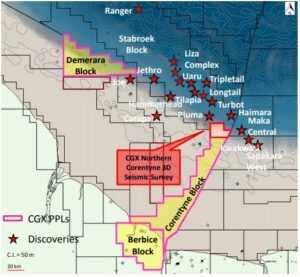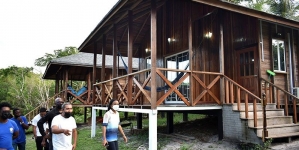CGX submits plans to relinquish 25% of Corentyne, Demerara and Berbice Oil Blocks
According to the petroleum agreements signed with oil companies as well as the overarching law for the industry, companies are expected to give up a portion of their blocks, whether on – or offshore, at the end of the first renewal period for their licences. In compliance with this, CGX Energy Inc. has submitted applications to the Department of Energy and the Guyana Geology and Mines Commission (GGMC) to relinquish 25% of its Demerara, Corentyne and Berbice Blocks.
This was noted in the company’s Quarterly Highlights for the three and six-month period ended June 30, 2020. CGX noted that the relinquishment of the said portions of the blocks was done in an effort to progress into the second renewal period for each of the Petroleum Prospecting Licences (“PPLs”). In the report, CGX said the Department of Energy “has officially indicated” that it sees no material obstacle to a favourable consideration of CGX progressing to the second renewal period in respect of the Corentyne, Demerara and Berbice PPLs, provided that relinquishment details necessary for progression into the second renewal period are agreed upon. CGX said that the department has also indicated that the second renewal period instruments in respect of the Corentyne, Demerara and Berbice Blocks can then be finalized immediately thereafter.

According to the company’s recently updated website, CGX Resources Inc. is the operator of the Corentyne Block under a Joint Operating Agreement (JOA) with Frontera Energy Guyana Corp. (“FEGC”). CGX reminded that it had contracted PGS Geophysical AS (PGS) to provide acquisition and processing of a full broadband marine 3D seismic survey over a northern segment of the Corentyne Block while noting that this was completed on November 2, 2019. The exercise produced seismic data covering approximately 582 km² of the northern portion of the Corentyne Block with processing completed on June 5, 2020.
The company has since completed the evaluation of the recently processed 3D seismic data and has identified two potentially highly prospective large channel sand reservoir complexes. These channel complexes have been interpreted to contain multiple high potential prospects located in the northern region of the Corentyne Block. This region is located in proximity to the Stabroek Block offshore Guyana and Block 58 offshore Suriname. The Pluma and Haimara discoveries in the Stabroek Block are located approximately two and eight miles respectively, from the border of the northern region of the Corentyne Block. Maka Central, Kwaskwasi-1 and Sapakara West discoveries in Block 58 are located approximately seven, 15 and 20 miles respectively, from the border of the northern region of the Corentyne Block.
Further to this, CGX said that the prospects mapped in the northern Corentyne Block are interpreted to be situated at the same geological horizons as the nearby significant discoveries already proven in the Stabroek Block and Block 58. It said too that the prospects identified on the northern region of the Corentyne Block have been interpreted to share the same proven hydrocarbon generating basin and intervals in which the current discoveries are located. Kaieteur News understands that these prospects are primarily stratigraphic traps composed of sandstone accumulations and deemed to be analogous to many of the discoveries already proven to be successful in the Guyana basin spanning both Guyana and Suriname.
As for the Demerara Block, CGX said noted that in 2014, it shot a 3,100 km² of 3D seismic survey that included gravity/magnetics over the Demerara Block. CGX said it then completed Time element (Pre Stack Time Migration) and Depth element (Pre Stack Depth Migration) processing of the seismic data. Based on this new data, CGX completed a fully integrated study of the block prospectivity. Prospect level maps were created along with a complete petroleum system evaluation. Kaieteur News understands that four high quality prospects were identified with a detailed analysis. An independent resource estimate report is currently in process.
With respect to its onshore block, CGX said there is strong evidence that oil has migrated onto the onshore Guyana Berbice Block and has been trapped. In this regard, it said that its 62% owned subsidiary, ON Energy Inc., had previously drilled three wells on the block and acquired 17 2D seismic lines along with an aeromagnetic and gravity survey. To augment these data, CGX said it conducted a Geochemical Soil Survey in late 2018.
Expounding further, it said that a surface soil gas survey was conducted by Exploration Technologies Inc. (ETI) in collaboration with the University of Guyana – Berbice Campus and several of the Berbice technical institutes. A total of 314 shallow soil gas vapors were collected between October 27 and November 4 of 2018 from a depth of four feet subsurface.
Kaieteur News understands that the results of this study are now being used to plan a 2D seismic survey and locate the drilling of a well.






















